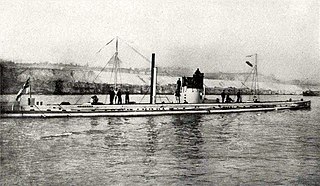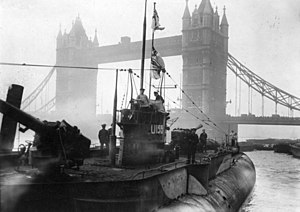
SM U-28 was a Type U 27 U-boat that served in the First World War. It conducted 5 patrols, sinking 40 ships totalling 90,126 GRT.

SM U-151 or SM Unterseeboot 151 was a World War I U-boat of the Imperial German Navy, constructed by Reiherstieg Schiffswerfte & Maschinenfabrik at Hamburg and launched on 4 April 1917. From 1917 until the Armistice in November 1918 she was part of the U-Kreuzer Flotilla, and was responsible for 34 ships sunk (88,395 GRT) and 7 ships damaged.

The Type UB III submarine was a class of U-boat built during World War I by the German Imperial Navy.

SM U-9 was a German Type U 9 U-boat. She was one of 329 submarines serving in the Imperial German Navy, and engaged in commerce raiding (Handelskrieg) during World War I.

Deutschland was a blockade-breaking German merchant submarine used during World War I. It was developed with private funds and operated by the North German Lloyd Line. She was the first of seven U-151-class U-boats built and one of only two used as unarmed cargo submarines.
SM U-156 was a German Type U 151 U-boat commissioned in 1917 for the Imperial German Navy. From 1917 until her disappearance in September 1918 she was part of the U-Kreuzer Flotilla, and was responsible for sinking 45 ships and damaging two others. She took part in the Attack on Orleans.

Bremen was a blockade-breaking German merchant submarine of World War I. Developed with private funds and operated by the Norddeutscher Lloyd Line, she was one of the first of seven U-151-class U-boats built and one of only two used as unarmed cargo submarines.
SM UC-63 was a German Type UC II minelaying submarine or U-boat in the German Imperial Navy during World War I. The U-boat was ordered on 12 January 1916, laid down on 3 April 1916, and was launched on 6 January 1917. She was commissioned into the German Imperial Navy on 30 January 1917 as SM UC-63. In nine patrols UC-63 was credited with sinking 36 ships, either by torpedo or by mines laid. UC-63 was torpedoed and sunk by HMS E52 off Goodwin Sands on 1 November 1917; only one crewman survived the sinking.
U-139, originally designated "Project 46", was a class of large, long-range U-boats built during World War I by the Kaiserliche Marine.
SM U-72 was one of 329 submarines serving in the Imperial German Navy in World War I. U-72 was engaged in the commerce war in First Battle of the Atlantic.
SM U-41 was one of the 329 submarines serving in the Imperial German Navy in World War I. U-41 engaged in naval warfare and took part in the First Battle of the Atlantic.

The SM UB-48 was a German Type UB III submarine or U-boat in the German Imperial Navy during World War I. It was commissioned into the German Imperial Navy on 11 June 1917 as SM UB-48.

SM UB-54 was a German Type UB III submarine or U-boat in the German Imperial Navy during World War I. She was commissioned into the Flanders Flotilla of the German Imperial Navy on 12 June 1917 as SM UB-54.

SM UB-64 was a German Type UB III submarine or U-boat in the German Imperial Navy during World War I. She was commissioned into the German Imperial Navy on 5 August 1917 as SM UB-64.

SM UB-67 was a German Type UB III submarine or U-boat in the German Imperial Navy during World War I. She was commissioned into the German Imperial Navy on 23 August 1917 as SM UB-67.

SM UB-72 was a German Type UB III submarine or U-boat in the German Imperial Navy during World War I. She was commissioned into the German Imperial Navy on 9 September 1917 as SM UB-72.

SM UB-73 was a German Type UB III submarine or U-boat in the German Imperial Navy during World War I. She was commissioned into the German Imperial Navy on 2 October 1917 as SM UB-73.

SM UB-78 was a German Type UB III submarine or U-boat in the German Imperial Navy during World War I. She was commissioned into the German Imperial Navy on 20 October 1917 as SM UB-78. Mined off Dover on 19 April 1918 all 35 crew lost.

SM UB-80 was a German Type UB III submarine or U-boat in the German Imperial Navy during World War I. She was commissioned into the German Imperial Navy on 8 September 1917 as SM UB-80.

SM UB-86 was a German Type UB III submarine or U-boat in the German Imperial Navy during World War I. She was commissioned into the German Imperial Navy on 31 October 1917 as SM UB-86.







